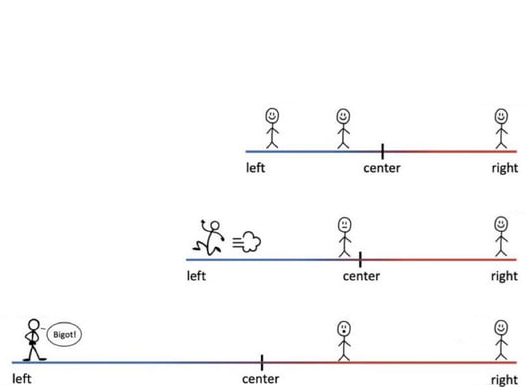Your cart is currently empty!

The Shifting Overton Window
There seems to be a widespread misconception in today’s political zeitgeist. We often hear claims that the Western world is veering dangerously toward Fascism, with terms like “far-right” being used so liberally that one might think Mussolini is running for office in the next election. However, upon closer examination, this narrative appears to invert reality. Over the last several decades, the American political landscape has experienced significant shifts, particularly within the Democratic Party, which has moved further to the left on various social issues. In contrast, the Republican Party has largely maintained its traditional stances, becoming more entrenched in these views as a response to the normalization and expansion of progressive social policies. Let’s examine some key details to better understand this shifting Overton window.
The Leftward Shift of the Democratic Party
Since the 1990s, the Democratic Party has progressively adopted more liberal positions on a wide range of social issues. This shift can be observed in their stances on immigration, abortion, gay marriage, gun control, taxes, and religion. For instance, Democrats have increasingly supported more lenient immigration policies, expanded abortion rights, legalized gay marriage, stricter gun control measures, progressive tax reforms, and a more secular approach to governance .
Kevin Drum’s analysis highlights that the Democratic Party’s movement towards more liberal positions has been significant. In the early 1990s, Democrats’ average position was moderately liberal, but by the late 2010s, it had shifted considerably further left. This trend reflects a broader acceptance and normalization of progressive policies within the party and among its supporters .
Let’s take a look at some evidence of this shift. The Week has referenced studies show that the Democratic Party’s base has become more radical, collectivist, and secular over the past 20 years. Younger Democrats, in particular, are more liberal compared to their older counterparts, further pushing the party to adopt more progressive policies .
Republican Stability and Entrenchment
On the other hand, the Republican Party has remained relatively stable in its ideological stance, maintaining traditional conservative views on social issues. While there have been some shifts, such as increased support for same-sex marriage among Republicans, these changes are less dramatic compared to the Democrats’ leftward movement .
The Pew Research Center notes that while both parties have become more ideologically consistent, the Republican Party’s shift to the right has been less pronounced than the Democrats’ shift to the left. By 2021, 94% of Democrats were to the left of the median Republican, up from 70% in 1994. This indicates that while Republicans have become more entrenched in their conservative views, their overall ideological position has not shifted as dramatically .
Polarization and Its Consequences
This asymmetrical polarization has resulted in increased political polarization in the United States. The ideological gap between the two parties has widened, with Democrats embracing more progressive policies and Republicans doubling down on their traditional conservative values. This dynamic has contributed to a more polarized political environment, where compromise and bipartisan cooperation have become increasingly challenging . The normalization of Democratic social policies has played a significant role in this polarization. As progressive policies become more mainstream, Republicans have responded by reinforcing their conservative positions, creating a feedback loop that further entrenches both parties in their respective ideologies .
The Reality
The Democratic Party has moved significantly to the left over the past few decades, adopting more progressive social policies as they become normalized within American society. The Republican Party, while maintaining its traditional conservative views, has become more entrenched in these positions as a response to the leftward shift of the Democrats. This dynamic has contributed to the growing political polarization in the United States, making bipartisan cooperation increasingly difficult. Studies from Kevin Drum and the Pew Research Center provide substantial evidence supporting this perspective, highlighting the divergent paths of the two major political parties in America.
For further reading:
- The Week: Democrats moved further left than Republicans moved right, statistical analysis finds
- Charts of the Day: Here’s a partisan history of the culture wars since 2000
- Washington Post: The Democratic Party has moved left — but so has the U.S.
- TIME Magazine: Democrats Begging Their Party to Ditch Activist Left
- The Atlantic: Democrats’ Long Goodbye to the Working Class
- Pew Research Center: Political Polarization in the American Public

Leave a Reply